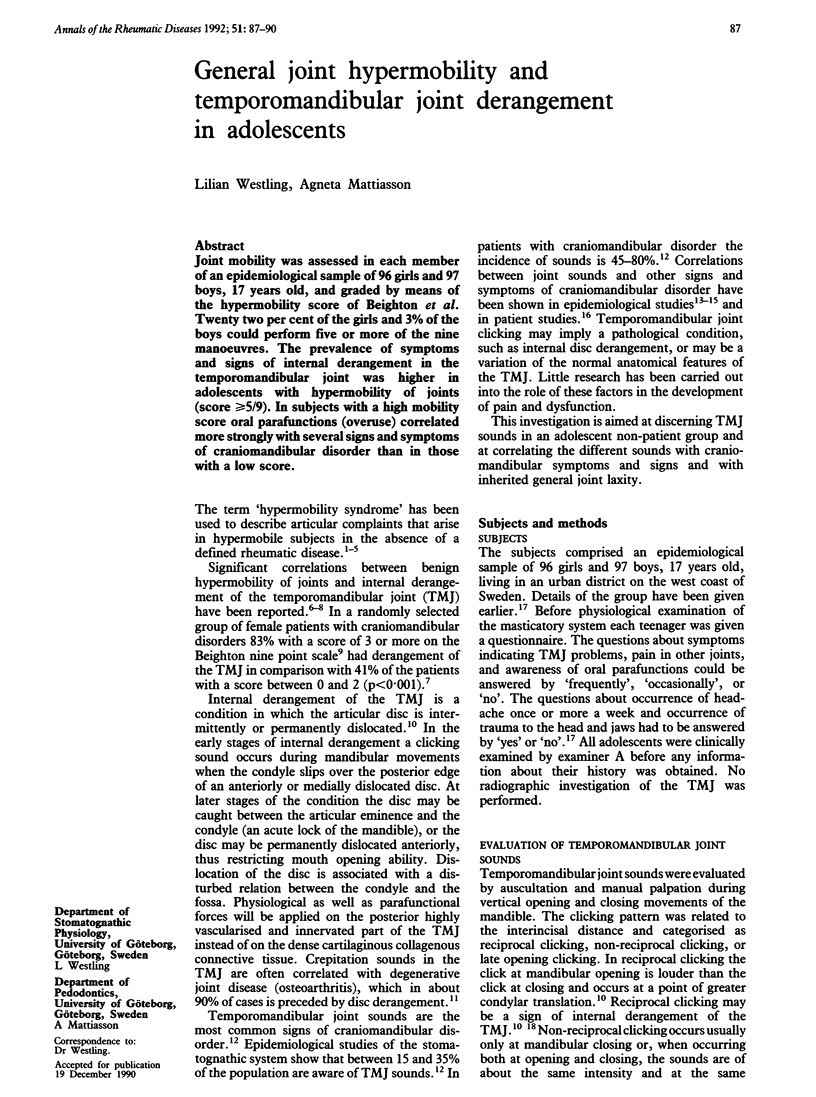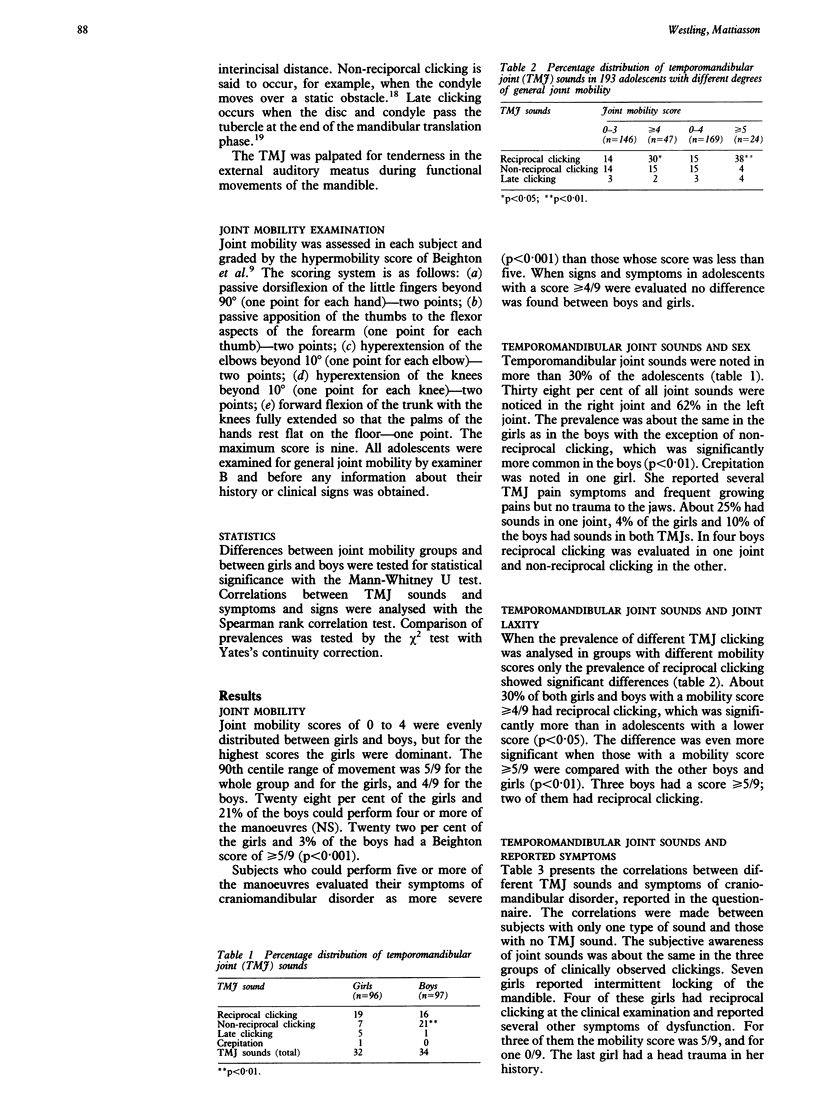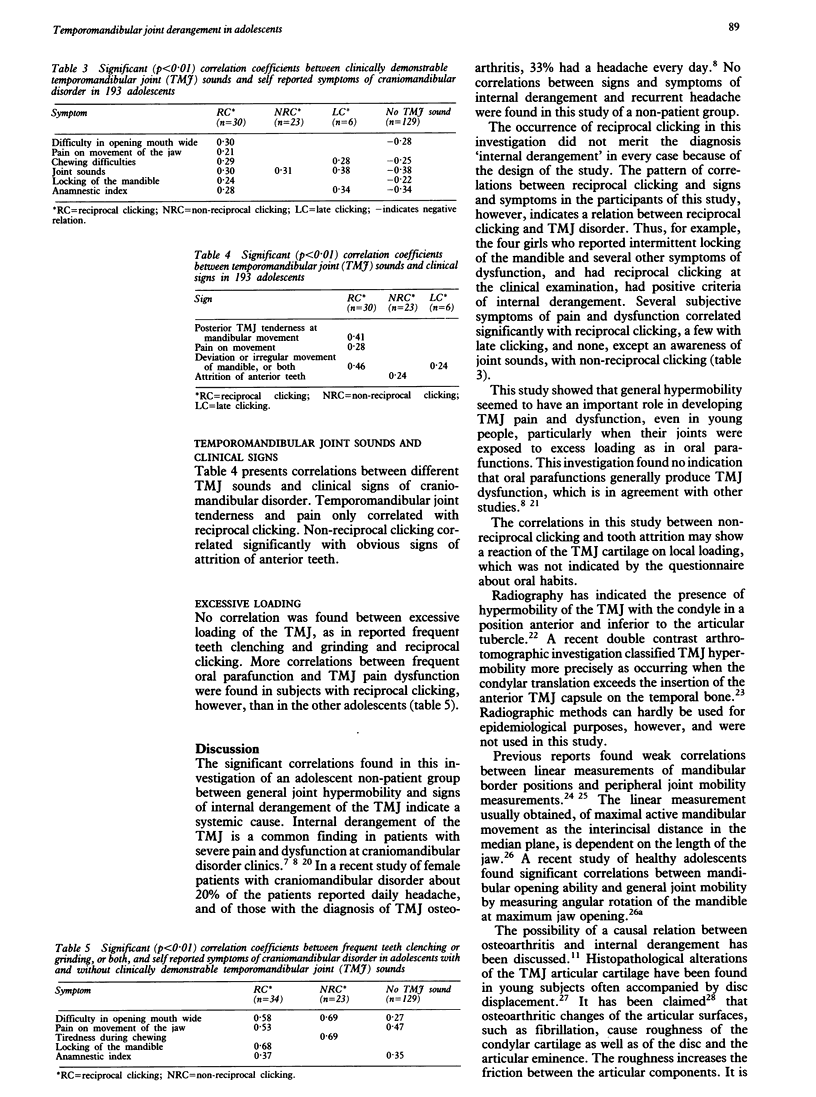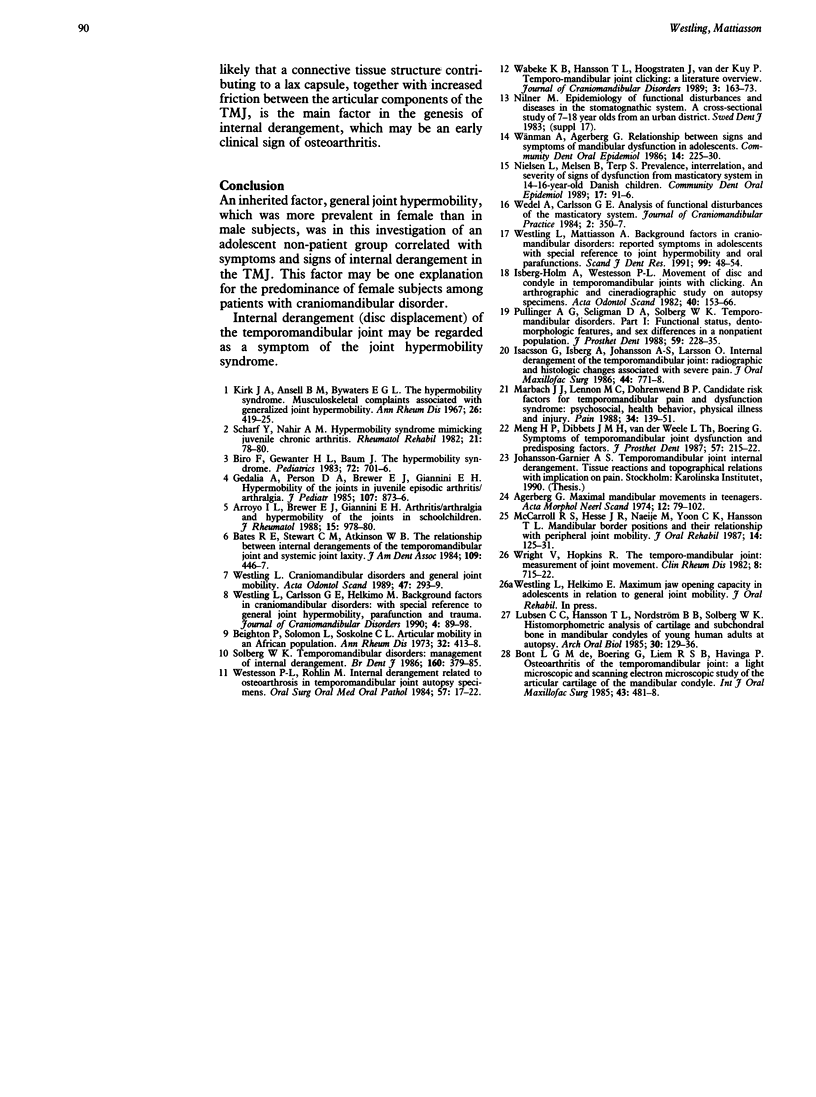Abstract
Joint mobility was assessed in each member of an epidemiological sample of 96 girls and 97 boys, 17 years old, and graded by means of the hypermobility score of Beighton et al. Twenty two per cent of the girls and 3% of the boys could perform five or more of the nine manoeuvres. The prevalence of symptoms and signs of internal derangement in the temporomandibular joint was higher in adolescents with hypermobility of joints (score greater than or equal to 5/9). In subjects with a high mobility score oral parafunctions (overuse) correlated more strongly with several signs and symptoms of craniomandibular disorder than in those with a low score.
Full text
PDF



Selected References
These references are in PubMed. This may not be the complete list of references from this article.
- Agerberg G. Maximal mandibular movements in teen-agers. Acta Morphol Neerl Scand. 1974 Jun;12(2):79–102. [PubMed] [Google Scholar]
- Bates R. E., Jr, Stewart C. M., Atkinson W. B. The relationship between internal derangements of the temporomandibular joint and systemic joint laxity. J Am Dent Assoc. 1984 Sep;109(3):446–447. doi: 10.14219/jada.archive.1984.0404. [DOI] [PubMed] [Google Scholar]
- Beighton P., Solomon L., Soskolne C. L. Articular mobility in an African population. Ann Rheum Dis. 1973 Sep;32(5):413–418. doi: 10.1136/ard.32.5.413. [DOI] [PMC free article] [PubMed] [Google Scholar]
- Biro F., Gewanter H. L., Baum J. The hypermobility syndrome. Pediatrics. 1983 Nov;72(5):701–706. [PubMed] [Google Scholar]
- De Bont L. G., Boering G., Liem R. S., Havinga P. Osteoarthritis of the temporomandibular joint: a light microscopic and scanning electron microscopic study of the articular cartilage of the mandibular condyle. J Oral Maxillofac Surg. 1985 Jul;43(7):481–488. doi: 10.1016/s0278-2391(85)80024-0. [DOI] [PubMed] [Google Scholar]
- Gedalia A., Person D. A., Brewer E. J., Jr, Giannini E. H. Hypermobility of the joints in juvenile episodic arthritis/arthralgia. J Pediatr. 1985 Dec;107(6):873–876. doi: 10.1016/s0022-3476(85)80178-5. [DOI] [PubMed] [Google Scholar]
- Isacsson G., Isberg A., Johansson A. S., Larson O. Internal derangement of the temporomandibular joint: radiographic and histologic changes associated with severe pain. J Oral Maxillofac Surg. 1986 Oct;44(10):771–778. doi: 10.1016/0278-2391(86)90151-5. [DOI] [PubMed] [Google Scholar]
- Kirk J. A., Ansell B. M., Bywaters E. G. The hypermobility syndrome. Musculoskeletal complaints associated with generalized joint hypermobility. Ann Rheum Dis. 1967 Sep;26(5):419–425. doi: 10.1136/ard.26.5.419. [DOI] [PMC free article] [PubMed] [Google Scholar]
- Lubsen C. C., Hansson T. L., Nordström B. B., Solberg W. K. Histomorphometric analysis of cartilage and subchondral bone in mandibular condyles of young human adults at autopsy. Arch Oral Biol. 1985;30(2):129–136. doi: 10.1016/0003-9969(85)90104-9. [DOI] [PubMed] [Google Scholar]
- Marbach J. J., Lennon M. C., Dohrenwend B. P. Candidate risk factors for temporomandibular pain and dysfunction syndrome: psychosocial, health behavior, physical illness and injury. Pain. 1988 Aug;34(2):139–151. doi: 10.1016/0304-3959(88)90159-5. [DOI] [PubMed] [Google Scholar]
- McCarroll R. S., Hesse J. R., Naeije M., Yoon C. K., Hansson T. L. Mandibular border positions and their relationships with peripheral joint mobility. J Oral Rehabil. 1987 Mar;14(2):125–131. doi: 10.1111/j.1365-2842.1987.tb00701.x. [DOI] [PubMed] [Google Scholar]
- Meng H. P., Dibbets J. M., van der Weele L. T., Boering G. Symptoms of temporomandibular joint dysfunction and predisposing factors. J Prosthet Dent. 1987 Feb;57(2):215–222. doi: 10.1016/0022-3913(87)90150-8. [DOI] [PubMed] [Google Scholar]
- Nielsen L., Melsen B., Terp S. Prevalence, interrelation, and severity of signs of dysfunction from masticatory system in 14-16-year-old Danish children. Community Dent Oral Epidemiol. 1989 Apr;17(2):91–96. doi: 10.1111/j.1600-0528.1989.tb00596.x. [DOI] [PubMed] [Google Scholar]
- Pullinger A. G., Seligman D. A., Solberg W. K. Temporomandibular disorders. Part I: Functional status, dentomorphologic features, and sex differences in a nonpatient population. J Prosthet Dent. 1988 Feb;59(2):228–235. doi: 10.1016/0022-3913(88)90019-4. [DOI] [PubMed] [Google Scholar]
- Scharf Y., Nahir A. M. Case report: hypermobility syndrome mimicking juvenile chronic arthritis. Rheumatol Rehabil. 1982 May;21(2):78–80. doi: 10.1093/rheumatology/21.2.78. [DOI] [PubMed] [Google Scholar]
- Solberg W. K. Temporomandibular disorders: management of internal derangement. Br Dent J. 1986 Jun 7;160(11):379–385. doi: 10.1038/sj.bdj.4805871. [DOI] [PubMed] [Google Scholar]
- Wabeke K. B., Hansson T. L., Hoogstraten J., van der Kuy P. Temporomandibular joint clicking: a literature overview. J Craniomandib Disord. 1989 Summer;3(3):163–173. [PubMed] [Google Scholar]
- Wedel A., Carlsson G. E. Analysis of functional disturbances of the masticatory system. J Craniomandibular Pract. 1984 Sep-Nov;2(4):350–357. doi: 10.1080/07345410.1984.11677878. [DOI] [PubMed] [Google Scholar]
- Westesson P. L., Rohlin M. Internal derangement related to osteoarthrosis in temporomandibular joint autopsy specimens. Oral Surg Oral Med Oral Pathol. 1984 Jan;57(1):17–22. doi: 10.1016/0030-4220(84)90251-2. [DOI] [PubMed] [Google Scholar]
- Westling L., Carlsson G. E., Helkimo M. Background factors in craniomandibular disorders with special reference to general joint hypermobility, parafunction, and trauma. J Craniomandib Disord. 1990 Spring;4(2):89–98. [PubMed] [Google Scholar]
- Westling L. Craniomandibular disorders and general joint mobility. Acta Odontol Scand. 1989 Oct;47(5):293–299. doi: 10.3109/00016358909007715. [DOI] [PubMed] [Google Scholar]
- Westling L., Mattiasson A. Background factors in craniomandibular disorders: reported symptoms in adolescents with special reference to joint hypermobility and oral parafunctions. Scand J Dent Res. 1991 Feb;99(1):48–54. doi: 10.1111/j.1600-0722.1991.tb01022.x. [DOI] [PubMed] [Google Scholar]
- Wright V., Hopkins R. The temporo-mandibular joint. Clin Rheum Dis. 1982 Dec;8(3):715–722. [PubMed] [Google Scholar]
- Wänman A., Agerberg G. Relationship between signs and symptoms of mandibular dysfunction in adolescents. Community Dent Oral Epidemiol. 1986 Aug;14(4):225–230. doi: 10.1111/j.1600-0528.1986.tb01540.x. [DOI] [PubMed] [Google Scholar]


